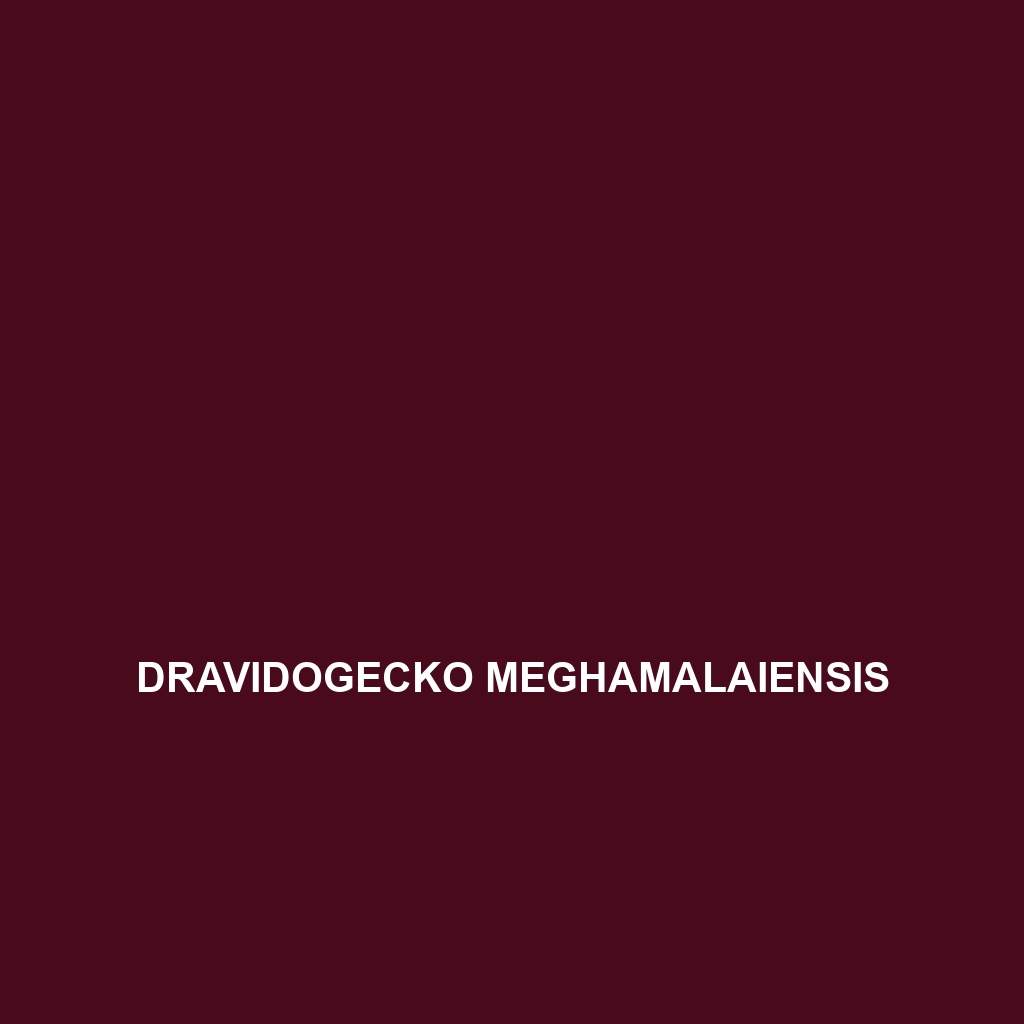Common Name
Dravidogecko meghamalaiensis
Scientific Name
Dravidogecko meghamalaiensis
Habitat
Dravidogecko meghamalaiensis is primarily found in the scenic landscapes of the Western Ghats in India, particularly in the Meghamalai region of Tamil Nadu. This species thrives in tropical and subtropical moist evergreen forests, which boast a humid climate and rich biodiversity. These rainforests provide a layered habitat structure, essential for their survival, offering numerous crevices and foliage for shelter and hunting. Additionally, this gecko’s habitat includes areas around hill slopes and rocky outcrops, where the microclimate is stable, supporting a plethora of endemic flora and fauna. Due to its specific habitat needs, Dravidogecko meghamalaiensis is sensitive to deforestation and habitat degradation, making conservation efforts in these regions crucial.
Physical Characteristics
The Dravidogecko meghamalaiensis exhibits unique physical characteristics that distinguish it from other gecko species. Adult individuals typically measure around 7 to 9 cm in length, showcasing a slender body with elongated limbs. Their skin is adorned with intricate patterns of dark and light shades, primarily in hues of brown and cream, which help them blend seamlessly into their rainforest surroundings. One distinctive feature of this species is its large, protruding eyes that afford excellent night vision, aiding their nocturnal lifestyle. Additionally, their adhesive toe pads are highly specialized, enabling them to navigate smooth bark surfaces and foliage with ease.
Behavior
Dravidogecko meghamalaiensis exhibits fascinating behaviors that are of considerable interest to researchers and enthusiasts alike. This gecko is primarily nocturnal, becoming active during the night when it ventures out to forage for food. Their social interactions are generally solitary, except during the mating season, where males exhibit territorial displays to attract females. Notably, the species has developed unique mating rituals involving colorful displays and vocalizations. In defense of their territory, males may engage in aggressive posturing, which displays their strength and vigor. Besides, the geckos are known to communicate through body language, utilizing their vibrant coloration changes to convey various social signals.
Diet
The diet of Dravidogecko meghamalaiensis primarily consists of a variety of small insects, making it an insectivore. Their feeding patterns are mainly opportunistic, feeding on crickets, moths, and other arthropods that become active during the night. With a quick flick of their tongue and agile movements, these geckos are adept hunters, capturing prey with precision. Their role as insectivores is vital in maintaining the ecological balance within their habitat, controlling insect populations and contributing to the intricate food web of the rainforest ecosystem.
Reproduction
The reproductive cycle of Dravidogecko meghamalaiensis typically occurs during the warmer months when climatic conditions are favorable. Mating season generally spans from late spring to early summer. After successful mating, females lay a clutch of 2 to 4 eggs, which they deposit in a sheltered area such as leaf litter or rocky crevices. The eggs have a gestation period of around 45 to 60 days, during which the female exhibits protective behaviors to guard her eggs from potential predators. Upon hatching, the young geckos are fully independent and begin their search for food and shelter. Parental care is minimal, reflecting a common trait among lizards.
Conservation Status
The conservation status of Dravidogecko meghamalaiensis is currently classified as vulnerable due to habitat loss and fragmentation primarily attributed to deforestation and agricultural expansion in the Western Ghats. Conservation efforts are underway, focused on habitat restoration and the establishment of protected areas within its native range. It is essential for ongoing research and monitoring to ensure that this unique species does not face further declines. Advocacy for awareness on the importance of preserving the Western Ghats ecosystem is crucial for the survival of Dravidogecko meghamalaiensis and other endemic species.
Interesting Facts
One fascinating aspect of Dravidogecko meghamalaiensis is its remarkable ability to adapt to various microhabitats within its range. Studies suggest that this gecko can change its coloration slightly, enhancing its camouflage against predators and providing an evolutionary advantage. Additionally, they are known for their chirping sounds during mating displays, embodying a unique form of communication among reptiles. These adaptations make the species not only resilient but also an intriguing subject for further research.
Role in Ecosystem
Dravidogecko meghamalaiensis plays a crucial role in its ecosystem. As an insectivore, it helps regulate insect populations, which is essential for sustaining the complex food web of the rainforest. The presence of this gecko in its habitat indicates the ecological health of the ecosystem, acting as a **bioindicator** of environmental changes. Furthermore, by contributing to the balance between prey and predator dynamics, it ensures the overall stability of its environment. Additionally, this species may also serve as prey for larger predators, thus integrating into larger ecological interactions.
